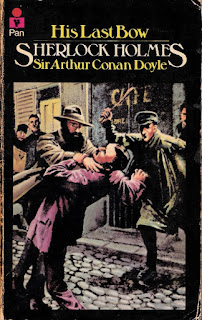The Plague Court Murders, published in 1934, was the first of the Sir Henry Merrivale mysteries written by John Dickson Carr under the pseudonym Carter Dickson. It boasts a fiendishly complex plot and yes, it is a locked-room mystery (Carr being universally acknowledged as the most enthusiastic practitioner of the locked-room mystery among all golden age writers of detective fiction).
There was something else Carr was noted for - his fondness for combining detective stories with very strong elements of the gothic. There is no shortage of gothic tropes in this novel.
Sir Henry Merrivale does not make his appearance until halfway through the book but once he arrives he takes centre stage.
The narrator, Ken Blake, worked for a top-secret branch of military intelligence during the Great War. Now he’s been drawn into some curious events in the life of Dean Halliday. Dean is now middle-aged but in his youth he was a bit of a hell-raiser. His now deceased brother James had an even more unfortunate history. These curious events concern James. Dean’s aunt and his fiancée have become involved with a psychic named Darworth. Dean doesn’t know what to think of all this. He is concerned and disturbed. Blake is willing to help but he feels this is a situation in which his friend Chief Inspector Masters may be very interested indeed. Masters has a special interest in phony mediums and other psychic scams. Masters is very anxious to become involved since the Darworth situation may be tied in to a strange theft from a London Museum - a dagger alleged to belong to a 17th century hangman’s assistant with a sinister reputation.
Blake, Masters and Dean Halliday set off for the grim house known as Plague Court, a house that has bee in the Halliday family for several hundred years and which they have never been able to sell or to rent. The ruined house is a suitably gothic setting for occult occurrences and Darworth is supposed to be exorcising it. In the grounds is a smaller single-room house which will be the setting for a murder, a house locked from both the inside and the outside with no possibility of entry by any other means.
There are a number of human suspects belonging to the circle of believers that had gathered around Darworth but there are inhuman suspects as well - some at least of those involved believe that spirits of the dead were responsible for the crime. This horrific crime may well be the sequel to equally terrible events in the 1660s.
Chief Inspector Masters, his sergeant and Blake are all on hand at the time the murder occurs but they can make nothing of it. Finally Blake realises it’s time to take the obvious step - to call in his old chief at the counter-espionage unit, Sir Henry Merrivale. It’s a difficult case but Merrivale has unbounded confidence in his own ability.
Merrivale is a delightful character. He’s wildly eccentric, rambunctious, rude, vulgar, opinionated, abrasive and has no social skills whatsoever. He is a qualified barrister, physician and rabid socialist. He is large and he is loud. Fortunately his confidence in himself is justified.
Phony spiritualists use many of the same tricks that stage magicians use. Writers of detective fiction use those tricks as well. Misdirection is the key to a successful stage illusion and Carr pulls off some pretty impressive misdirection in this story.
Carr lays out all the clues for us, but is this really a fair-play mystery? The plot is so twisted and the solution is so off-the-wall that I can’t imagine many readers solving the puzzle. They may certainly solve parts of it, but not the whole thing. There are also one or two plot points which really stretch credibility to the limit. Having said that it’s undoubtedly a tour-de-force of grandiose and grotesque ingenuity.
It was quite common in golden age detective fiction for characters to remind us of the essential artificiality of the puzzle-plot mystery school by saying things like, “This isn’t a detective story you know.” I don’t think anyone pushed that tendency further than Carr - at one point Sir Henry Merrivale dismisses one proposed solution on the grounds that the suspect in question can’t be the murderer because he was introduced too late in the story and that’s against the rules of detective fiction.
Carr is regarded as one of the masters of plotting but while the plot of The Plague Court Murders is indubitably impressive it wasn’t the element that impressed me most of all. For me the highlights of this book are Carr’s superb gift for creating gothic atmosphere and his magnificent creation of the outrageous, deplorable but immensely entertaining Sir Henry Merrivale.
The Plague Court Murders is a treat. Highly recommended.





